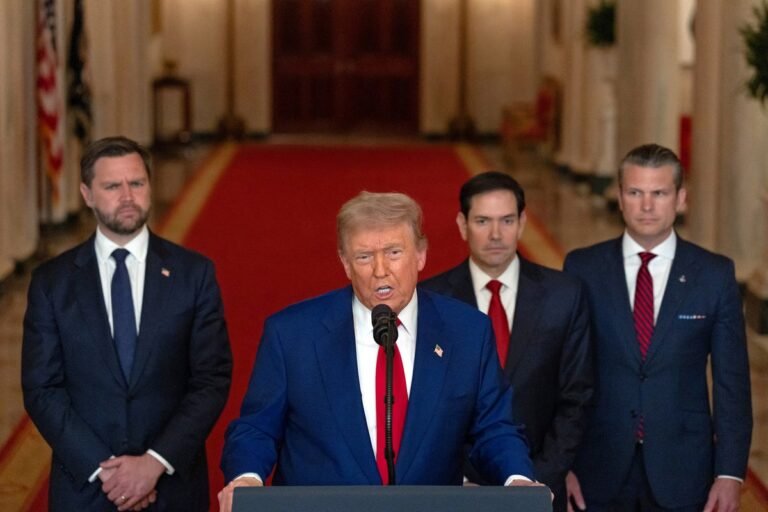Did the U.S. Really Destroy Iran’s Nuclear Program?
Nuclear policy specialist David Albright explains how his organization is monitoring for damage to nuclear sites following U.S. and Israeli strikes
U.S. President Donald Trump with members of his cabinet following strikes on Iran.
Carlos Barria/Pool/AFP via Getty
Many in the world woke to the news on 22 June that the United States had bombed nuclear sites in Iran, with the goal of destroying the nation’s ability to produce nuclear weapons. The raids targeted Iran’s uranium-enrichment facilities in Fordow and Natanz, and its nuclear research centre in Isfahan, using stealth bombers to drop massive ‘bunker-busters’, and cruise missiles.
Although Iran says its nuclear programme is for peaceful purposes, experts have long assessed that Iran was close to having the capability of building nuclear weapons if it chose to do so. The US attacks followed a bombing campaign by Israel, which has since carried out further attacks on Iranian nuclear facilities. On 23 June, the International Atomic Energy Agency reported that “very significant damage is expected to have occurred” at the underground Fordow site.
Researchers at academic institutions and think tanks are also assessing the potential impacts of the attacks on Iran’s nuclear capabilities. Analysts have said that the attacks probably set the nuclear programme back substantially, but not permanently. In particular, Iran could have moved stockpiles of highly-enriched uranium, and perhaps some enrichment centrifuges, elsewhere. David Albright, a nuclear policy specialist and president of the Institute for Science and International Security in Washington DC, spoke to Nature about what researchers know.
On supporting science journalism
If you’re enjoying this article, consider supporting our award-winning journalism by subscribing. By purchasing a subscription you are helping to ensure the future of impactful stories about the discoveries and ideas shaping our world today.
How do you assess the impact of the bombings on Iran’s nuclear capabilities?
There aren’t many researchers who are able to assess the impact of the bombings. We have decades of experience with the Iranian nuclear programme, so we know their facilities and activities very well. And we have great access to satellite imagery — which we have to buy. We try to buy some every day. And we utilize analysts who have decades of experience to analyze these images. We also have lots of contacts with governments, and we have colleagues who also have contacts with governments.

Maxar Satellite Imagery shows extensive damage at the Fordow underground complex. Several large craters are visible across the ridge, and a wide area is covered in grey-blue ash, consistent with airstrike aftermath.
Satellite image (c) 2025 Maxar Technologies.
A lot of the damage is on the surface, so it’s a question of knowing what the building did [in terms of its role in the nuclear program]. We rely on our repository of information about the sites that are attacked. So it’s pretty straightforward.
Obviously, more problematic is the underground sites. When we initially assessed Israel’s bombing of Natanz, three days later I saw a very small crater above the underground hall. I could work out and link it to a type of Earth-penetrator weapon that Israel is known to have. It would leave a really small crater when it went in, and the damage would be underground. The United States bombed it with a much more powerful Earth penetrator. So damage is probably more extensive.
How and when will we know for sure the extent of the damage?
As nuclear experts, we’d like to see this done with diplomatic agreements, where Iran would allow intrusive inspections into its programme. If that does not happen, then it’s the job of US and Israeli intelligence to assess the damage. They’re looking at communications intercepts, or trying to recruit people on the inside to reveal information.
Would there be radioactive materials detected outside Natanz, Esfahan and Fordow if the attacks were successful?
So far, the IAEA reports no such leaks. And it appears that Iran had moved the enriched uranium stockpiles in the days before the bombings. The United States has said that the target of its bombings was the facilities, so they understand they are not getting at the nuclear material.
Can shockwaves damage enrichment facilities even without a direct hit?
Shockwaves can cause a lot of damage. They will push against the centrifuges, and if they’re spinning, it can cause the rotor inside to crash against the wall. It’s anyone’s guess how much is destroyed without additional information. But the idea of the US bombing was that Israel may not have done enough damage.
Would it pose more serious environmental risks if Iran’s Bushehr nuclear power plant were bombed?
Israel has said it will not attack nuclear reactors. And Israel negotiated with Russia not to attack the Russians who operate Bushehr. But yes, it really could be disastrous. The decay products of uranium fission that accumulate inside a reactor are much more dangerous than the uranium itself. That’s why you don’t want to have a nuclear reactor involved in a war.
This article is reproduced with permission and was first published on June 23, 2025.
[source_link


